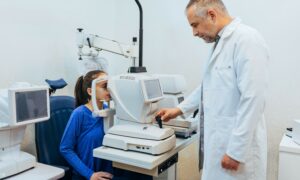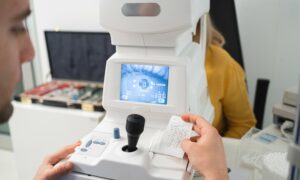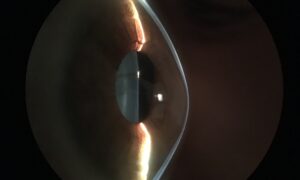July 1, 2024
By Dwight Akerman, OD, MBA, FAAO, FBCLA, FIACLE
The article “Effectiveness of Orthokeratology and Myopia Control Spectacles in a Real-World Setting in China” by Yang, Liu, and Cho, published in Contact Lens and Anterior Eye in 2024, aims to compare the efficacy of myopia control in Chinese children using orthokeratology lenses versus next-generation myopia control spectacles (MCS) in a real-world setting.
The study involved 212 patients with baseline myopia ranging from -0.75D to -5.00D, who had undergone myopia control treatment with either OrthoK (Euclid (OK1) or CRT (OK2)) or MCS (Stellest (MCS1) or DIMS (MCS2)) for at least one year. The effectiveness of myopia control among the four groups was compared based on the change in spherical equivalent refraction (SER) for the spectacle groups and axial length (AL) for all groups.
The study found that there were no significant differences in gender, cylindrical power, or best corrected visual acuity (BCVA) at the baseline visit among the four groups. However, there were significant differences in baseline age, myopia, and axial length among the groups. Nonetheless, after one year of treatment, there was no significant difference in axial elongation (AE) among the four groups. Compared with historical controls, the average axial elongation retardation in one year ranged from 0.18 to 0.20 mm, which is comparable to previous reports on myopia control using OrthoK lenses.
Additionally, the study identified age as a significant factor associated with axial elongation and SER increase. There were negative associations between AE and age in all groups, indicating that younger patients had greater axial elongation. Moreover, there was a positive association between SER increase and baseline age in the spectacle groups, suggesting that older patients experienced a more significant increase in myopia with the use of myopia control spectacles.
It is recognized that results between RCT and real-world studies may differ. Although RCTs are the “gold standard” for evaluating treatment efficacy, they are usually conducted on very selective populations and under controlled settings to significantly reduce the influence of known or suspected confounding factors by randomization. The many limitations of RCTs restrict their ability to describe what actually occurs in the real world. These limitations include rigorous patient selection, focusing only on patients who comply with and respond better to the treatment, which can lead to over-estimation of the treatment effects, higher frequency of assessments and visits compared to routine clinical practice, and special clinical settings that differ from most general practice settings. Thus, results from RCTs may not truly represent the actual population, and results from diverse situations that may be present in real-world clinical scenarios are needed. However, real-life trials have higher generalizability and lower internal validity due to their characteristic design. Results of both RCTs and real-life trials may help overcome their relative limitations and provide a better guide to eye care practitioners with respect to the effectiveness of different therapeutic options.
In conclusion, this study provides valuable insights into the effectiveness of OrthoK and myopia control spectacles in a real-world setting in China. The findings suggest that both OrthoK lenses and myopia control spectacles are effective in controlling myopia progression in children with mild to moderate myopia. The results of this study can inform clinical decision-making and contribute to the development of personalized treatment plans for myopic children.
Abstract
Effectiveness of Orthokeratology and Myopia Control Spectacles in a Real-World Setting in China
Bi Yang, Longqian Liu, Pauline Cho
Objective: To compare the effectiveness of myopia control in Chinese children, who had been wearing either orthokeratology (OrthoK) lenses or myopia control spectacles (MCS) for one year.
Methods: Relevant data were retrieved from 212 patients, with baseline myopia of -5.00 to -0.75 D, astigmatism ≤ 1.50 D, who had been undergoing myopia control treatment with either OrthoK (Euclid (OK1) or CRT (OK2)) or MCS (Stellest (MCS1) or DIMS (MCS2)) for at least one year. Myopia control effectiveness among the four groups was compared based on the change in spherical equivalent refraction (SER) (for the spectacle groups) and axial length (AL) (for all groups). Data was retrieved from the right eye only, including best corrected visual acuity (BCVA), SER, and AL at both the initial clinic visit (baseline) and the one-year visit was analyzed.
Results: Although no significant differences in gender, cylindrical power, or BCVA were observed at the baseline visit (P > 0.05), there were significant differences in baseline age, myopia, and AL among the four groups (P < 0.05). No significant difference in axial elongation (AE) was found among the four groups after one year of treatment (P = 0.49). AE, adjusted for baseline age and spherical power, were 0.19 ± 0.15, 0.18 ± 0.14, 0.19 ± 0.19, 0.20 ± 0.18 mm for OK1, OK2, MCS1, MCS2, respectively. Only age was a significant factor associated with AE and SER increase (P < 0.05), with negative associations between AE and age in all groups and positive association between SER increase and baseline age in the spectacle groups observed.
Conclusion: Both brands of OrthoK lenses and MCS had similar myopia control effectiveness for mild to moderate myopic children treated in a real-world setting in China. Average AE in one year ranged from 0.18 to 0.20 mm, comparable to previous reports on myopia control using ortho-k.
Yang, B., Liu, L., & Cho, P. (2024). Effectiveness of orthokeratology and myopia control spectacles in a real-world setting in China. Contact Lens and Anterior Eye, 47(3), 102167.
DOI: https://doi.org/10.1016/j.clae.2024.102167














